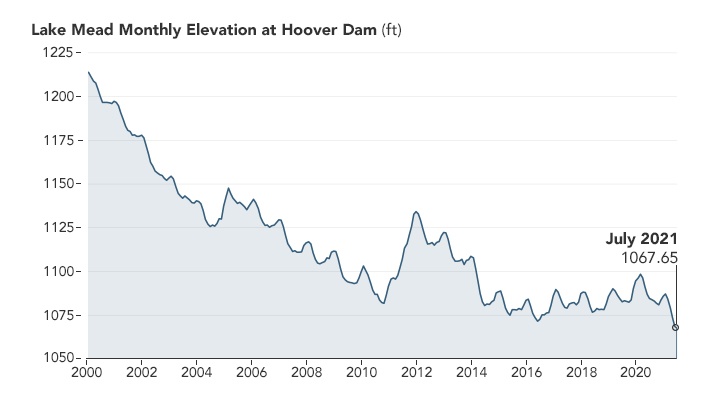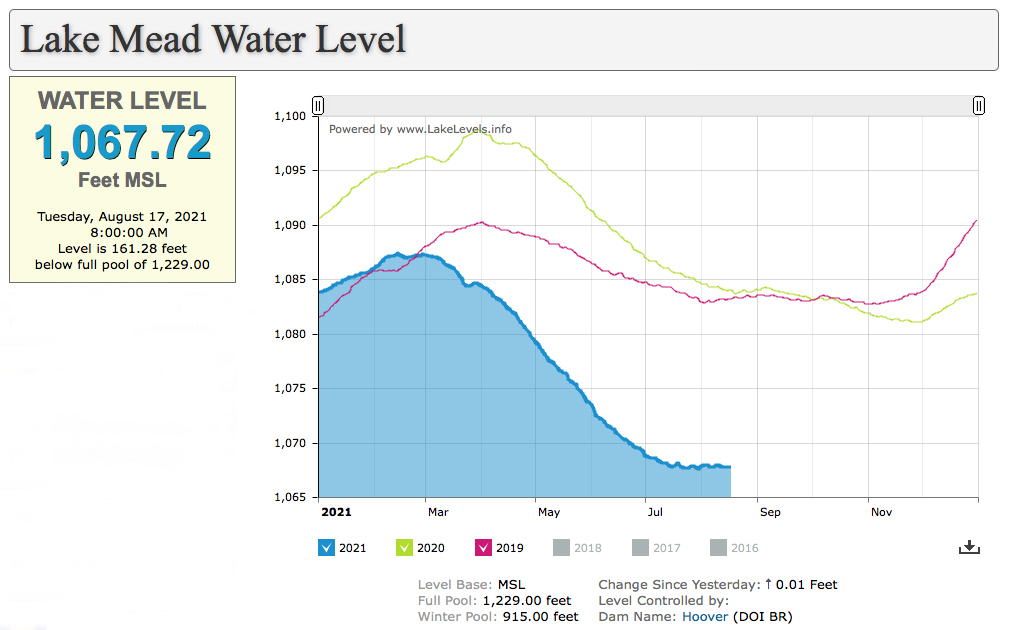Peter Lobner, updated 17 September 2011
At its maximum capacity, Lake Mead water level is at an elevation of 1,220 feet (372 meters) at the Hoover Dam and holds 9.3 trillion gallons (36 trillion liters) of water. It was last at its maximum capacity in 2000 and has been declining since then as shown in the following graph.

In my 18 June 2021 post, I discussed the Lake Mead water supply for Las Vegas and the alarming trend of decreasing water level in Lake Mead as a result of the persistent drought in the watershed for the Colorado River.
In July, the Bureau of Reclamation began releasing additional water from reservoirs upstream of Lake Powell (which is upstream of Lake Mead) in an attempt to stabilize the lake level and maintain hydropower generation at the Glen Canyon dam (which forms Lake Powell).
The following chart shows that the Lake Mead water level was at 1,067.72 feet on 17 August 2021, more than seven feet below the 1,075 foot threshold for triggering a water shortage declaration. The lake level appears to have temporarily stabilized, possibly benefiting from the increased releases into upstream Lake Powell.

On 16 August 2021, the Bureau of Reclamation issued their much anticipated projection of 2022 operating conditions for Lake Powell and Lake Mead. They reported:
“Given ongoing historic drought and low runoff conditions in the Colorado River Basin, downstream releases from Glen Canyon Dam and Hoover Dam will be reduced in 2022 due to declining reservoir levels. In the Lower Basin the reductions represent the first “shortage” declaration—demonstrating the severity of the drought and low reservoir conditions.”
The planned actions in response to this first-ever shortage declaration take effect on 1 January 2022, as described in the Bureau’s news release here: https://www.usbr.gov/newsroom/#/news-release/3950
In summary, the following cuts in Colorado River water allocations are expected:
- Arizona: Loses 18% of the state’s annual apportionment
- Nevada: Loses 7% of the state’s annual apportionment
- Mexico: Loses about 5% of the country’s annual allotment
California has more senior water rights than Arizona and Nevada and will be spared immediate cutbacks when they are implemented on 1 January 2022.
Additional cuts in water allocations will be triggered if Lake Mead water level continues to decline to the following thresholds: 1,050 feet, 1,045 feet, and 1,025 feet.
Let’s pray for a lot of wet weather in the US southwest.
For more information
- Sam Metz, “West prepares for possible 1st water shortage declaration,” Nevada Appeal, 19 April 2021: https://www.nevadaappeal.com/news/2021/apr/19/west-prepares-possible-1st-water-shortage-declarat/
- Gia Yetikyel, “Hoover Dam’s Lake Mead Hits Lowest Water Level Since 1930s,” Smithsonian Magazine, 18 June 2021: https://www.smithsonianmag.com/smart-news/hoover-dams-lake-mead-hits-lowest-water-level-1930s-180978022/
- Luke Runyon, “Colorado River Basin Reservoirs Begin Emergency Releases To Prop Up A Troubled Lake Powell,” KUNC, 15 July 2021:https://www.kunc.org/environment/2021-07-15/colorado-river-basin-reservoirs-begin-emergency-releases-to-prop-up-a-troubled-lake-powell
- “Reclamation announces 2022 operating conditions for Lake Powell and Lake Mead – Historic Drought Impacting Entire Colorado River Basin,” Bureau of Reclamation, 16 August 2021: https://www.usbr.gov/newsroom/#/news-release/3950
- Nancy Atkinson, “Here’s Lake Mead’s Record Low Water Levels Seen From Space,” Universe Today – Space and astronomy news, 7 September 2021: https://www.universetoday.com/152460/heres-lake-meads-record-low-water-levels-seen-from-space/